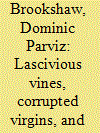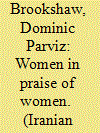|
|
|
Sort Order |
|
|
|
Items / Page
|
|
|
|
|
|
|
| Srl | Item |
| 1 |
ID:
127784


|
|
|
|
|
| Publication |
2014.
|
| Summary/Abstract |
The Persian wine production myth centers on the relationship between a male vintner and his female vine and her daughters, the grapes. This myth, the earliest extant examples of which are found in qas?das by the Samanid poets R?dak? and Bashsh?r Marghaz? and which was much developed by Man?chihr? and his contemporary Farrukh?, contains images of femininity, the mother-child bond, separation, violence, execution, and ultimate redemption. The grape harvest comes in the late summer and culminates in the Mihrag?n festival, a celebration focused on the grape and grape wine, at which poems containing versions of the wine production myth were recited. The present study maps the evolution of this myth over the span of a century through a close reading of eleven poems with specific reference to variations in narrative structure.
|
|
|
|
|
|
|
|
|
|
|
|
|
|
|
|
| 2 |
ID:
137393


|
|
|
|
|
| Summary/Abstract |
This study examines the Jamshid of Ferdowsi's Shahnameh and its later reception, specifically the Islamic refashioning of Jamshid in fourteenth-century Shiraz, as evidenced in the ghazals of Hāfez (d. 1389), and the lyric poetry of Khvāju-ye Kermāni (d. 1352 or 1360), and ʿObeyd-e Zākāni (d. 1371). Hāfez, Khvāju, and ʿObeyd used literary devices such as talmih (allusion) and ubi sunt to both engage with and reshape the past, and this refashioning of the past was employed to legitimize their patrons’ authority to rule from Shiraz. The article culminates in an exploration of the mytho-political dimensions of the conflation of Jamshid with Solomon and the intimate association of this composite figure with Fars in the Ilkhanid and post-Ilkhanid periods. Poetry is treated here as a productive force that both shapes and is shaped by the socio-political circumstances of its composition, performance, and reception. In order to locate the thirteenth- and fourteenth-century reconfiguration of Jamshid within its geo-mythological context, use has been made of the concept of lieu de mémoire as a means through which to unpack the trans-historical cultural impact on Shiraz of the ancient Achaemenid and Sasanian ruins that surround the Islamic city; ruins that have for more than two millennia embedded a sense of proximity to history in the land and peoples of Fars.
|
|
|
|
|
|
|
|
|
|
|
|
|
|
|
|
| 3 |
ID:
092946


|
|
|
|
|
| Publication |
2009.
|
| Summary/Abstract |
This article discusses the representation of Turks in the kulliy t (collected works) of the fourteenth-century poet 'Ubayd-i Z k n? (d. 1371). 'Ubayd is well known for his satirical works (e.g. M sh u gurba, Akhl q al-ashr f), but his courtly poetry (in particular his ghazals and qas?das) have yet to receive substantial scholarly attention. This study examines the various ways in which 'Ubayd presents Turks in his kulliy t, whether as an object of erotic desire, a figure to be feared on account of his violent nature, or else as a metaphor for the royal patron or other member of the ruling elite of fourteenth-century Shiraz. This article explores the tension that exists in 'Ubayd's works between these various depictions of the Turk, shows how references to Turks in bawdy prose works and other poetic genres (such as rub '?) can be used to interpret those found in more chaste ghazals, and discusses the possible implications the depiction of the Turk found in 'Ubayd's kulliy t may have for our understanding of references to Turks in the poetry of his contemporaries, in particular H fiz (d. 1389).
|
|
|
|
|
|
|
|
|
|
|
|
|
|
|
|
| 4 |
ID:
118790


|
|
|
|
|
| Publication |
2013.
|
| Summary/Abstract |
This study examines the poetry of two women of nineteenth-century Iran-one royal, one non-royal-and the women patrons for whom they composed praise poetry. Through the reconstruction of female-centered patronage networks and associated female-only performance venues, and via an examination of the active roles played by female patrons both in affairs of state and in the management of the immense royal harem, this study highlights the various ways in which members of several generations of women in Qajar Iran were involved in the production, dissemination and appreciation of poetry. It is argued here that these patronage and poetry production networks should be read as evidence of a female-centered literary tradition, one that was in dialogue with (and often intersected) the dominant male tradition; one that empowered the women actors within it to create a sisterhood of poets through which their art could be passed on from mother to daughter, and from daughter to granddaughter (and occasionally from mother to son).
|
|
|
|
|
|
|
|
|
|
|
|
|
|
|
|
|
|
|
|
|